Much as the “Curse of the Bambino” hung over Boston for decades following the infamous decision of the Red Sox to sell slugger Babe Ruth to the Yankees, so too has the site of Les Halles in Paris been plagued after the market was dismantled in 1969 and the pavilions demolished in the 1970s. Back in its day, Les Halles served as the city’s central fresh food market and, in many ways, the heart of Paris.
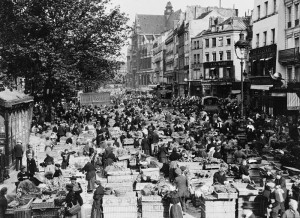
Les Halles market in Paris, circa 1920
Emile Zola famously wrote about Les Halles as the belly of Paris (his book Le Ventre de Paris depicts the market and its vendors during the 19th century in colorful detail). It was widely loved, although having grown large it strained against the confines of its location and became beset with problems—clogged traffic, debris piles, and rat infestations among them. Even so, the city’s decision to shut down Les Halles and shift the wholesale market distribution to Rungis, a suburb of Paris, was met with an outpouring of public despair. That was nearly 50 years ago, but to this day one still hears lamentations of the loss of this great market.

Babe Ruth in 1918, the year before he was traded to the Yankees
Just as Red Sox fans endured a dearth of World Series championships after the trade of the Bambino, so too have Parisians had to cope with the punishing aftermath of the decision to close Les Halles in the form of poorly designed and atrocious looking repurposings of the site. For the past 30 years or so, it’s been a combination of dreary underground shops and a torturous hub of Métro lines (Châtelet-Les-Halles). Adding to the complexity, it’s also a terminus for RER trains. An estimated 750,000 rail passengers transit this station each weekday. Forum des Halles was a soulless behemoth in the middle of an otherwise mind-bogglingly beautiful city.
In 2010, when the city of Paris began yet another excavation and redesign of the public space, it was met with wary anticipation and weary skepticism. So many times in the past city planners had gotten it wrong, raising hopes that they would develop something worthy of the hallowed site and then dashing them. This time they put the choice of architects up for referendum. They solicited designs and allowed the public voice in the choice.
During my recent visit to Paris, I was eager to see the progress on the newest incarnation of Forum des Halles.
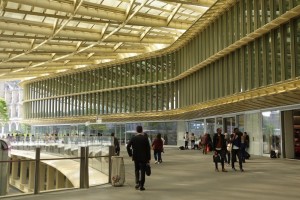
Newly redesigned Forum des Halles in Paris
The redevelopment project includes a refurbished underground shopping center, redesigned transportation concourses, a gigantic roof structure called La Canopée which stretches across a wide plaza above ground, and gardens.
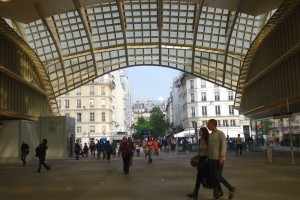
Several commercial and cultural establishments line the perimeter of the patio, but most activity is underground where there are stores, movie theaters, a pool, La Forum des Images, and train lines. Urban planners are keen to attract people of all ages.
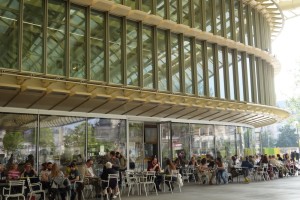
patio area under La Canopée
The roof structure, or La Canopée, pays homage to the past but also is modernistic. Undulating curves of steel and glass resemble a honeycomb, or lettuce leaves overlapping at the edges to invoke a market reference. It also vaguely echoes the soaring glass ceiling which was a hallmark of Victor Baltard’s design of the old Les Halles. Reactions have been mixed according to this New York Times article (and borne out by any conversation with more than one Parisian).
I like La Canopée’s visual impact, although the overhang is not sealed and becomes problematic during heavy rains. But visually, the design is dramatic in a way that Paris can pull off. I’m thinking of I.M. Pei’s glass pyramid at the Louvre, a marriage of old and new architecture that ends up being surprisingly harmonious. La Canopée is a stretch, both literally and figuratively. It spans a wide patio and escalators that lead underground. It lures people, whether hordes of commuters who must pass through or pedestrians mesmerized by the sight who choose to be drawn toward it.
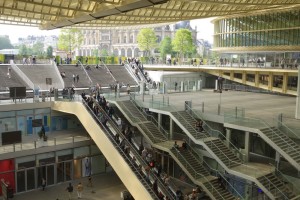
escalators leading to the underground complex
La Canopée largely succeeds in its architectural and social ambitions. It brings coherence and dynamism to this major public space. I don’t feel that way, unfortunately, about the underground area. It’s a mashup of shops, restaurants, cinemas, Métro and RER lines.

They’ve managed to attract many brand-name enterprises. The movie offerings are good. But the space continues to be cavernous and confusing. Personally, I don’t see the appeal of being underground when I’m in Paris. I long for the street action and natural light.
One big part of the design that hasn’t been completed yet are the public gardens named in honor of Nelson Mandela.
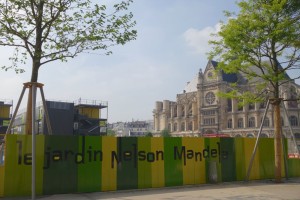
Jardin Nelson Mandela underway
Construction is underway, and the plans show promise. The grounds will integrate greenery, pedestrian pathways, giant chessboards, pétanque courts, and play areas. Hopefully they will restore colorful ambiance to what had been concrete blight ever since Les Halles was torn down.
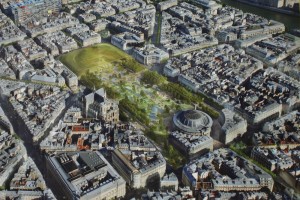
artistic rendering of the grounds
The Red Sox managed to reverse the Curse of the Bambino when they finally won another World Series championship in 2004 after an 86-year drought. With any luck, the new Forum des Halles can also succeed at finally putting to rest the unsettled spirit of Les Halles.
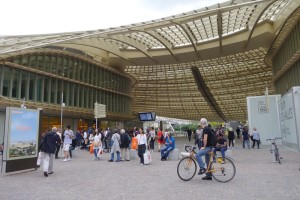
Details:
Forum des Halles is located at 10, rue Berger, in the 1st arrondissement of Paris. It’s open daily from 10 am to 8 pm, except Sunday when it’s open 7 am to 7 pm.
